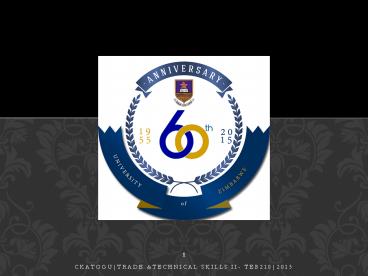Water Control Systems - PowerPoint PPT Presentation
Title: Water Control Systems
1
(No Transcript)
2
WATER FLOW CONTROL SYSTEMS
3
- Is achieved by fitting stop corks on various
points of the supply pipes. - Allows water to be turned off for repair work or
replacement of pipes.
4
Valves used for water
- Valves are equipment designed to stop or regulate
flow of water in its path. - Types
- Stop valve(globe type)
- Drain valve
- Gate or sluice valve
- Portsmouth/pistol float valve.
- Diaphragm float valve.
- Croydon float valve.
- Materials for valves
- Brass- for temperatures up to 100 OC.
- It contains 50 zinc and 50 copper.
- Gun metal- for higher temperatures.
- It contains 85 copper, 5 zinc and 10 tin.
5
Glob-type stop valve
- Used to control the flow of water at high
pressure. - To close the flow of water the crutch head handle
is rotated slowly in a clockwise direction
gradually reducing the flow, thus preventing
sudden impact and possibility of vibration and
water hammer.
6
Gate or sluice valve
- Used to control the flow of water on low pressure
installations. - The wheel head is rotated clockwise to control
the flow of water, but this valve will offer far
less resistance to flow than a globe valve. - Opens by lifting a round or rectangular
gate/wedge out of the path of water.
7
Drain valve
- Have several applications and is found at the
lowest point pipe systems, boilers and storage
vessels.
8
Float valves
- These are automatic flow control devices fitted
to cisterns to maintain an appropriate volume of
water. - Each pipe supplying a cold water storage cistern
should be fitted with a ball valve to prevent the
overflow of water. - An authority ball valve is designed to
automatically regulate the supply of water by
floating the ball to close the valve when water
reaches a predetermined level.
9
Other Valves
- Portsmouth/pistol float valve.
- Diaphragm float valve.
- Croydon float valve.
10
Valve In A Toilet Cistern
- Portsmouth and Croydon valves have a piston
moving horizontally or vertically respectively. - Water outlets must be well above the highest
water level to prevent back siphonage of cistern
water into the main supply
11
Toilet Cistern
- Disc or piston flushing cistern.
- Can be made out of plastic or ceramic.
- Depressing the lever or handle raises the piston
and water is displaced over the siphon. - A siphonic action is created to empty the
cistern.
12
Taps Used For Water
- All piped water is controlled and accessed
through a tap unless there is a burst within the
piping system. - Basically there are two types of tapes which are
- Pillar
- Bib
13
Parts Of A Tap
14
Pillar tap
- Used to supply water to basins, baths, bidets and
sinks - Combined hot and cold pillar taps are available
with fixed or swivel outlets.
15
Quarter-turn ceramic disc pillar tap
- Easy to operate by hand or elbow.
- Suitable for use by the disabled and medical
practitioners
16
Bib Tap
- Bib tap is for wall fixing.
- Normally about 150mm above a sanitary appliance.
17
Conventional bib tap
- Bib tap is for wall fixing.
- Normally about 150mm above a sanitary appliance.
- Tap can be supported by the upright water pipe
supply. - Usually in gardens.
18
How To Repair a Leaking Tap
- Tools
- pliers with adjustable jaws
- a vice grip
- a shifting spanner of the correct size
- a screw driver.
- PROCEDURE
- Firstly, turn of the main water valve or
stopcock. - Once this is done, open the tap to relieve the
pressure and to empty the tap of any remaining
water.
19
- Remember to put the plugs in the bath or basin of
the tap you are repairing so that you do not
loose any small screws down the drain. - Dismantle the tap and remove the worn washer.
This is done by unscrewing the tap head. - Unscrew the bell-shaped cover and remove.
- Lay the parts down in the same order you remove
them to simplify reassembly.
20
- Unscrew the head part with water pump pliers, or
a similar tool, and remove. - Unscrew the washer retaining nut and remove the
faulty tap washer. - Replace with a new washer of the same size,
thickness and type. - Replace the nut. Remember not to over-tighten the
nut as this may damage the new washer. - Re-install the spindle and screw down the cover.
- Close the tap.
- Restore the water supply and check again for
leaks.
21
- If your tap is still dripping even once the
washer has been replaced, there is a chance it
may need to be reseated. - Reseating is often required because of grit
present in the tap, or general wear-and-tear. You
will need to call a plumber to reseat your tap
for you so that it is sealed correctly with the
proper tool. - Also, if you find that you are constantly
repairing a leaking tap, it may mean that the tap
itself is worn and needs replacing. - Some taps cannot be disassembled, which means the
entire tap will need to be replaced. Certain
modern taps come with soft rubber washers that
can be easily damaged if too much force is used
when closing the tap. - If you are uncertain as to how to repair a
leaking tap, or if a repaired tap continues to
leak, consider consulting a plumber.
22
Happy anniversary































